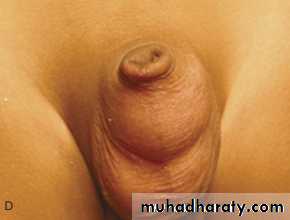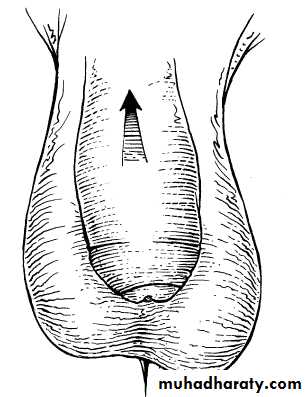CONGENITAL ANOMALIES OF URETHRA & PENIS
CONGENITAL URETHRAL LESIONSAnatomy
Male urethra is a tubular structure extending from the bladder neck to the external urethral meatus(EUM) at the tip of the glans penis. It is composed of 4 parts:
Prostatic urethra posterior urethra
Membranous urethra
Bulbar urethra anterior urethra
Penile urethraProstatic urethra contain verumontanum(important landmark).
The external urethral sphincter is composed of striated muscle within the urethral wall .
• Urethral stricture
• rare, may be associated with duplication of urethra.• Symptoms are delayed till adolescence when it may not be differentiated from traumatic urethral injury.
• Rx.:
• Optical urethrotomy
• Urethral dilation.
• 2. Congenital urethral valves
• Anterior urethral valves• rare, cause urethral dilation &diverticulum. They are manifested by UTI, urine incontinence. They are treated by endoscopic fulgration.
• b. Posterior urethral valves
• congenital mucosal folds located just distal to the verumontanum or within the prostatic urethra. They are flap valves therefore urethral catheterization can be done inspite of reduced urine stream.
• Clinically,
• Prenatally diagnosed by U.S.(as hydronephrosis).• 2. Recurrent UTI in neonates.
• 3. Urine incontinence in toddlers with urine dribbling.
• 4. Delayed presentation in adolescence as urinary tract obstruction ,hydroureteronephrosis &renal failure.
Investigations:
U.S. , IVU, MCUG( it shows the valve folds, the trabeculated bladder with diverticulae & even vesicoureteral reflux).
Cystourethroscopy confirm the Dx.
Rx.:
Endoscopic valve resection.
Pt. with renal failure & hydrureteronephrosis need vesicostomy till stabilizing renal function then endoscopic valve ablation.
• Hypospadias
• incidence : 1 in 300• the commonest congenital urethral disease.
• Definition: the external urethral meatus(EUM)opens on the ventral side of the penis prximal to the tip of the glans penis or on the scrotum or perineum.
• There may be poorly developed ventral part of the prepuce( hooded prepuce).
• There may be ventral penile curvature(chordee).
• Aetiology
• Congenital incomplete fusion of the urethral folds.• Esrogens & progestins given in prgnancy increase its incidence.
• Classification
• According to the position of the meatus:
• Glanular hypospadias
• the commonest type.
• 2. Coronal hypospadias
• the EUM lies on the ventral side of the junction of the glans & penile shaft.
3. Penile & penoscrotal hypospadias
4. Perineal hypospadiasthe most severe type associated with bifid scrotum, maldescended testes & difficult sex determination.
Rx.
The glanular type needs no Rx. Unless the meatus is stenosed which needs meatotomy, however surgery is needed for the other types.
Time of surgery: 6-18 montha of age.
Aim of surgery
improve sexual function.Improve urine stream.
Cosmotic reasons.
Steps of surgery:
Orthoplasty(correction of penile chordee).
Urethroplasty(correction of the site of the EUM).
Glanuloplasty(correction of the shape of the glans).
There are many types of operations for hypospadias, most of them use the prputial skin therefore circumcision should be
Delayed till hypospadias repair succeeded.
4. Epispadiasvery rare. The EUM lies on the dorsum of the penis & associated with upward curvature of the penis.
It might coexists with bladder exstrophy & other severe congenital defects.
5. Diverticulum of male urethra
Congenital partial duplication of the urethra. It is uncommonly acquired (where it is due to increased intraurthral pressure behind a urethral stricture or due to the lonstanding presence of a stone in the urethra).It is treated by excision & treating the cause.
• CONGENITAL ANOMALIES OF THE PENIS
• Phimosis• a scaring prepuce which becomes tight & cant be retracted over the glans.
• It can cause difficult urination or may hide a stenosed meatus, so it can cause back pressure effect on the ureters& kidneys. It should be differentiated from the physiologic adhesions between the the foreskin & glans.
• It is caused by chronic infection under the prepuce with poor local hygiene & may arise because of balanitis xerotica obliterans( a thickened foreskin which doesn’t retract over the glans).
• Rx. : circumcision.
• Indications of circumcision:
• Religious or cultural habits.
• Phimosis & paraphimosis.
• Recurrent UTI or balanoposthitis
• 4. Obstruction of urine flow.
• 5. In adults for inability to retract the prepuce for intercourse.
2. Paraphimosis
A tight retracted foreskin that act as a ring & is difficult to return back normally over the glans. It is caused by chronic infection under the prepuce . This ring causes venous & lymphatic obstruction of the glans which becomes swollen & this will further increase the pressure effect of the ring.Rx.:
Gentle manual squeezing of the glans+ icebags.
Circumcision(if the first step fails).















